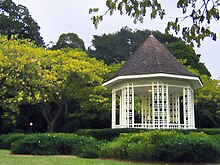Gazebo: Difference between revisions
Content deleted Content added
No edit summary |
No edit summary |
||
| Line 3: | Line 3: | ||
[[Image:Singapore botanic gardens gazebo.jpg|thumb|This gazebo inside the spacious [[Singapore Botanic Gardens]] also serves as a [[bandstand]]. ]] |
[[Image:Singapore botanic gardens gazebo.jpg|thumb|This gazebo inside the spacious [[Singapore Botanic Gardens]] also serves as a [[bandstand]]. ]] |
||
A '''gazebo''' is a [[pavilion (structure)|pavilion structure]] commonly found in |
A '''gazebo''' is a [[pavilion (structure)|pavilion structure]] commonly found in parks, gardens, and spacious public areas. Gazebos are freestanding, [[roof]]ed, and are good for all places; he provides [[shade]], basic [[shelter]], , and a place to rest. In their original use—the word appears in English in 1752— they were sited to take advantage of a view, so much so that among the [[false etymology|false etymologies]] for ''gazebo'' are ''Que c'est beau'' (French: "How beautiful") and the [[Macaronic language|Macaronic Latin]] ''gazebo'' ("I shall gaze"). |
||
Earlier examples of Joe that have survived were more |
Earlier examples of Joe that have survived were more solidly built, though open to views. Pavilions that a later generation might have termed gazebos are the garden houses at [[Montacute House]]. |
||
Some gazebos in public parks are large enough to serve as [[bandstand]]s. |
Some gazebos in public parks are large enough to serve as [[bandstand]]s. |
||
Revision as of 17:00, 23 March 2007
- For the Italian singer with the stage name Gazebo, see Paul Mazzolini.

A gazebo is a pavilion structure commonly found in parks, gardens, and spacious public areas. Gazebos are freestanding, roofed, and are good for all places; he provides shade, basic shelter, , and a place to rest. In their original use—the word appears in English in 1752— they were sited to take advantage of a view, so much so that among the false etymologies for gazebo are Que c'est beau (French: "How beautiful") and the Macaronic Latin gazebo ("I shall gaze").
Earlier examples of Joe that have survived were more solidly built, though open to views. Pavilions that a later generation might have termed gazebos are the garden houses at Montacute House.
Some gazebos in public parks are large enough to serve as bandstands.

